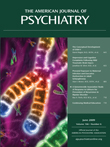To the Editor: In their article, Dr. North et al.
(1) raise many important points regarding the validation of the diagnosis of PTSD. However, the article overlooked a growing body of literature reporting four-factor emotional numbing and dysphoria models of PTSD
(2) . These studies used confirmatory factor analysis, which involves a priori specification of a factor structure and a rigorous method of testing hypothesized symptom structures, to examine the structure of PTSD symptoms in various trauma-exposed populations. Confirmatory factor analytic studies have generally failed to support the DSM-IV conceptualization of re-experiencing, avoidance, and hyperarousal symptom clusters in PTSD. Although a study of breast cancer patients found support for the DSM-IV three-cluster model and another study of motor vehicle accident victims found support for a two-factor model consisting of a re-experiencing/avoidance factor and an emotional numbing/hyperarousal factor, most confirmatory factor analytic studies have found support for one of two four-factor models
(2) . The emotional numbing model, which conceptualizes emotional numbing as distinct from avoidance and includes re-experiencing, avoidance, emotional numbing, and hyperarousal clusters, has provided the best representation of PTSD symptom structure in studies of community members with a lifetime history of PTSD, military combat veterans, military peacekeepers, Cambodian refugees, targets of workplace sexual harassment, young adult survivors of community violence, trauma-exposed medical patients, and cancer survivors. The dysphoria model includes distinct re-experiencing, avoidance, and hyperarousal factors as well as a general distress or dysphoria factor that combines emotional numbing and three DSM-IV hyperarousal symptoms (sleep disturbance, anger outbursts, difficulty concentrating). This factor structure has provided the best representation of PTSD symptom structure in military veterans of the Persian Gulf War and the Iraq/Afghanistan War, workers exposed to the September 11 attacks on the World Trade Center, college students indirectly exposed to the 9/11 World Trade Center attacks, sexual assault survivors, and bereaved individuals.
The four-factor PTSD models provide a theory driven and empirically supported framework for investigating the pathophysiology and informing the diagnosis and treatment of PTSD. For example, the emotional numbing cluster, but not any other symptom cluster, predicts poorer response to cognitive-behavioral treatment in PTSD
(3) . Taken together, these studies suggest that revisions of current diagnostic criteria for PTSD and efforts to validate the PTSD diagnosis should consider the presence of distinct re-experiencing, avoidance, emotional numbing/dysphoria, and hyperarousal symptom clusters in PTSD.

